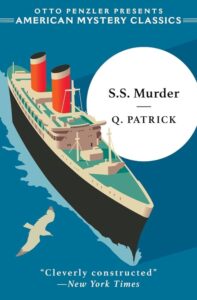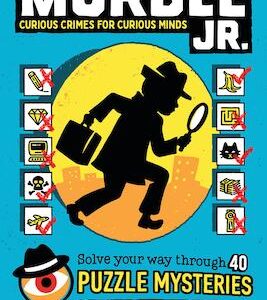Peripatetic Anglo-American mystery writers from the Golden Age of detective fiction did their share of sailing over deep waters, not merely metaphorically but in fact, so it is no surprise that in the years between the first and second World Wars that shipboard mysteries, like those set in locked rooms, quaint villages and country houses, became a notable subgenre of their own. (They might be considered a subset of transportation mysteries, which included not only ships but planes, trains, buses and automobiles.)
Intriguing examples of Golden Age shipboard crime novels—fine reads all—include Rufus King’s Murder by Latitude (1930), C. Daly King’s Obelists At Sea (1932), Q. Patrick’s S.S. Murder (1933), Elizabeth Gill’s Crime De Luxe (1933), John Dickson Carr’s The Blind Barber (1934), Agatha Christie’s Death on the Nile (1937), Freeman Wills Crofts’ Found Floating (1937) and Carter Dickson’s Nine-and Death Makes Ten (1940).
SS Murder, the tale of murderous charm and verve which concerns us here, was produced by a pseudonymous author who is one of the most enigmatic crime writers ever to have put typewriter key to typing paper during the Golden Age of detective fiction. Or in this case I should say not one, not two, not three, but four authors, for “Q. Patrick” was in fact nothing less than a quartet of distinct—and distinctly talented—individuals.
The author was launched in 1931 by thirty-year-old Philadelphia pharmaceutical executive Richard “Rickie” Wilson Webb, a restlessly energetic native Englishman who had a yen for mystery writing but preferred working in collaboration with others. Rickie’s first writing partner, who joined him in the composition of Cottage Sinister (1931) and Murder at the Women’s City Club (1932), was Martha Mott Kelley, an Amazonian twenty-four-year-old graduate of Radcliffe College of genteel Philadelphia heritage who rather resembled American aviator Amelia Earhart. Her family and friends nicknamed her “Patsy.”
Together Patsy and Rickie devised the mystery writing pseudonym of Q. Patrick by combining “Pat” and “Rick” to make “Patrick” and then adding the letter “Q,” because, the pair later explained, they considered “Q” the most intriguing letter of the alphabet. With the publication of S.S. Murder in 1933, readers were informed that the “Q” stood for “Quentin”—though this name was never otherwise acknowledged. Three years later Rickie would reverse the names Quentin and Patrick to derive what would become the most famous of all his pseudonyms: Patrick Quentin.
After the publication of the second Q. Patrick novel, Patsy abandoned Rickie for another man, as it were, wedding another native son of England and leaving the United States with him to reside in his home country for the remainder of her life.
Having been left high and dry by his erstwhile partner, Rickie wrote the next Q. Patrick opus, Murder at Cambridge (Murder at the ‘varsity in the UK), solo, drawing heavily on his own experiences in England as a student at Cambridge in the early Twenties.
Apparently he found the experience unduly onerous, for when it came to producing the fourth Q. Patrick crime tale, SS Murder, later that year, he turned to another female collaborator, thirty-one-year-old Mary Louise White, a reader at The Atlantic Monthly. Descended, like Patsy Kelley, from an old genteel Philadelphia Quaker family, Mary Lou, as she was nicknamed, had graduated from Bryn Mawr, done additional studies at Harvard and Yale, and, like Rickie, spent heady youthful days in Paris during the Jazz Age.
Taking advantage of their wide experience of Transatlantic travel in the Roaring Twenties, Rickie and Mary Lou in September 1933 published SS Murder, an ingenious and zestfully written tale which draws on the then hugely popular card game of bridge, anticipating by three years Agatha Christie’s detective novel Cards on the Table. As in Christie’s classic mystery, a tabulation of bridge scores is included in the volume as a clue. There is as well a footnoted sort of Challenge to the Reader in the teasing style of Ellery Queen.
Probably much of the writing of SS Murder was done by Mary Lou and the bulk of the plotting by Rickie. Like Murder at Cambridge before it, the novel was published, in contrast with the first pair of Patricks, by a major book company, Farrar & Rinehart, who included in its stable that bestselling author of mysteries (and mother of partners in the firm), Mary Roberts Rinehart. Additionally the next year Farrar & Rinehart would pick up Rex Stout, whose Nero Wolfe detective series would quickly become one of the most popular in crime fiction.
Befitting its prestigious publisher, SS Murder produced Q. Patrick’s best reviews to date.
In the Saturday Review “Judge Lynch” (aka William C. Weber) proclaimed that the tale stood “high among popular aquatic mysteries,” with “[l]ively dialogue, spooky atmosphere, and [a] puzzling problem,” while in the New York Times Book Review Isaac Anderson opined that a “more cleverly constructed murder yarn than this one would be difficult to find anywhere.” In England, the New Statesman and Nation approvingly declared: “The plot is sound, the style lively and dramatic with plenty of surprises.”
S.S. Murder was also admiringly referenced by miracle problem maestro John Dickson Carr in “The Grandest Game in the World,” his landmark essay on Golden Age detective fiction. It is fair, I think, to suggest that it influenced Carr’s shipboard radio mystery play Cabin B-13 (1943), filmed a decade later as Dangerous Crossing.
Two notices from lesser known sources are especially striking in their praise of SS Murder. “Here is a dandy item for the mystery fans,” wrote a delighted reviewer in the Salt Lake Tribune, adding: “Q Patrick, who is a mystery himself, or herself—the latter would be our guess—shows admirable inventiveness and constructive skill, and the story’s shocks and thrills are counterbalanced by a lively humor reminiscent of Mary Roberts Rinehart. ‘S. S. Murder’…is no penny thriller; its characters are flesh-and-blood people, and the story has literary competence.” Going several steps further in her laudations, Dorothy Williams of the Camden (New Jersey) Courier Post proclaimed the novel:
“guaranteed to give you an evening of breathless entertainment, whether or not you like detective stories….There are several suspicious people on board and I selected the murderer before I was halfway through the book. I was wrong, to my great chagrin, but I had a perfectly swell case against the original one.
You can’t possibly appreciate the suspense in this book till you read it. This reviewer can truthfully say that she can’t remember the day when a book of this type kept her biting her nails so furiously.”
Like Wilkie Collins’ landmark detective novel The Moonstone and Margaret Cole’s Burglars in Bucks and Dorothy L. Sayers’s The Documents in the Case, both published a few years earlier in 1930, S. S. Murder is also an epistolary mystery novel. It is told in the form of letters written to her journalist fiancée by the appealingly presented Mary Llewellyn, a prominent lady newspaper columnist, while she is traveling from New York City to Rio de Janeiro aboard the luxury ocean liner S. S. Moderna.
In an amusing bit of meta-fiction in the foreword—the kind of thing mystery writers often indulged in during the Golden Age, when death was so frequently treated as a game—we learn that the letters were turned over for publication to none other than that clever mystery writer Q. Patrick.
From reading Mary’s letters we learn that on the second day of the voyage of the Moderna, wealthy elderly businessman Alfred Lennox suddenly dropped dead from strychnine poisoning during a pleasant game of bridge in the ship’s smoking room (floor plan included). The finger of suspicion is soon pointed at a nondescript passenger named Mr. Robinson, who had been one of the bridge players at the table on that fatal night, but since has unaccountably vanished. Other significant passengers on the ship are:
– the late Lennox’s younger second wife (now widow) Mabel, formerly in show business
– his seemingly sweet-natured “flapper niece” Betty
– his handsome young secretary Jimmie Earnshaw, who has dark hair and a “black mustache like [film actor] John Gilbert’s” and “seems practically plastered to [Betty]”
– widowed Mrs. Clapp–formerly Marcia Manners, the famed monologist–and her mannish companion, Daphne Demarest, “who looks like an Olympic discus hurler”
– Mr. Wolcott, “white-haired, goateed and very much a gentleman”
– Senor Silvera, “so dark and Spanish and sinister looking that you know he must be henpecked or kind to animals or that he practices the flute in his cabin”
– Mr. Daniels, “a funny little Cockney”
– Adam—not Aaron—Burr, a “nice and restful” individual (though possibly an aspiring “sugar daddy”), who quickly befriends Mary Llewellyn
Two days after Mr. Lennox’s demise, another passenger is thrown overboard to his/her certain death—could this be the fatal hands of the mysteriously missing Mr. Robinson at their murderous work yet again? Is there a clue in Mary Llewellyn’s letters to her fiancé? Certainly the murderer seems to think so, for he starts sending threatening missives to Mary! Despite the presence of a callous double slayer aboard the ship, however, the spirited journalist’s account of events, while exciting, never loses its savoir faire and firm focus on the question of whodunit, in keeping with the carefree canons of classic detective fiction.
After examining Mary’s letters the captain of the Moderna pronounces, in another amusing meta moment, that they constitute as good a crime saga as anything ever written by “[Arthur] Conan Doyle or Mrs. Rinehart”—a reference not only to the late Grand Old Man of mystery but to the mother of Q. Patrick’s publishers. Elsewhere, Patrick goes himself one better by having Mary backhandedly compliment his own immediately previous detective novel, Murder at Cambridge:
“I got undressed after I’d finished writing to you and settled down in bed with a novel—a detective story you gave me by that friend of yours, Quentin Patrick. I found it very nice and restful after the thrills and horrors of this voyage—pleasant milk and water after a steady diet of highballs. And, as I read it, I couldn’t help thinking if your ingenious buddy can make so much out of a synthetic situation in a dull old English university, what could he not do with a real, red-hot, full-blooded sort of mystery as we’ve been having on board the S. S. Murder?”
The answer to Mary’s question is that Quentin Patrick did quite well with it indeed. Something in the American air seemed to invigorate Rickie Webb. Certainly his writing partner helped him as well. Unfortunately the talented team of Rickie and Mary Lou was fated to be one of mystery’s one-hit wonders. On New Year’s Day, 1934, Rickie’s collaborator wed Edward Campbell Aswell, her former boss at The Atlantic Monthly and an editor at Harper & Brothers who would become closely associated in the thirties with the works of novelist Thomas Wolfe.
In contrast with Martha Mott Kelley, who withdrew from literary endeavors after her marriage, Mary Lou Aswell, as she was now known, herself became the hugely influential fiction editor at Harper’s Bazaar, in which position she fostered the careers of such literary luminaries as Eudora Welty, Truman Capote, Carson McCullers and Patricia Highsmith, all of whom remained her lifelong friends.
After divorcing Edward Aswell (with whom she had a son and daughter) and her second husband, novelist Fritz Peters, author of the classic 1951 queer novel Finistere (both Aswell and Peters were gay), Mary Lou relocated to Santa Fe, New Mexico, where she maintained a long-term same-sex partnership with the artist Agnes Sims and in 1957 authored a single solo domestic suspense novel, Far to Go.
In Santa Fe she and Agnes were occasionally visited by Patricia Highsmith, who during a 1970 sojourn to the city recorded in her journal: “Here lives Mary Louise Aswell, who bought “The Heroine” for Harper’s Bazaar when I was twenty-three. She lives with Agnes Sims in a very pretty house with some Ibizan dogs.” (“The Heroine,” a nasty psychological murder tale, was Highsmith’s first published piece of fiction, written when she was a student at Barnard College.)
Rickie Webb likewise took up with a same-sex partner in the 1930s, a prodigiously talented and devastatingly handsome young English university graduate named Hugh Wheeler. Rickie and Hugh would live together, some martial months during World War Two excepted, for the next eighteen years, from 1933 until an acrimonious parting in 1951. Together under three pseudonyms, Q. Patrick, Patrick Quentin and Jonathan Stagge, the two men would produce some of mystery fiction’s finest crime novels.
Hugh would continue writing Patrick Quentin tales solo–not to mention write the Tony award-winning books to the seventies musicals A Little Night Music, Candide, and Sweeney Todd–after he evicted Rickie from the “firm” and their home in the Berkshire Hills of Massachusetts. Rickie returned to Paris, where he died obscurely in 1966.
Plagued with a variety of physical and mental maladies and heartbroken after the loss of his adored Hugh, the love of his life, Rickie died something of a broken man; yet he always took pride in having originated not one but a full trio of the most notable names in crime fiction. Along with Q. Patrick’s devilishly perverse The Grindle Nightmare, the delightful SS Murder is the finest detective novel which Rickie wrote without apparent help from Hugh. (Grindle sometimes is mistakenly co-credited to Mary Lou Aswell.)
Readers are urged to enjoy this classic Golden Age shipboard mystery in remembrance of Richard Wilson Webb, one of the most sadly underappreciated men of classic mystery.
***
Excerpted from Curtis Evans’ introduction to S.S. Murder, by Q. Patrick. Published by American Mystery Classics. Copyright, 2024. Reprinted with permission. All rights reserved.


















